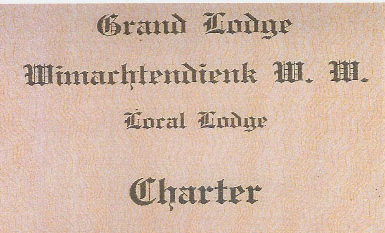The ceremonies of the Wimachtendienk and later the Order of the Arrow were written down and passed around so that there was similarity of the rituals in all Lodges. However, we do not have the earliest ceremony in any form.
The 1915 ritual that took place on each Friday night of camp at Treasure Island does not exist. There is even disagreement about the content of that ceremony among those who were there and witnessed it.
The first written ceremony that exists is the private ceremony used in the city after camp that eventually became the Second Degree. Dr. William Hinkle wrote that ceremony and the known copy available has hand written corrections over the typing. This copy dates to circa 1918.
The written Ordeal Ceremony first appeared in 1921 with the formation of the Grand Lodge. The ceremony was mimeographed on 8.5 x 11 inch paper and distributed to the Supreme Chief of the Fire of each member lodge. The names of the ceremonialists and the content of the ceremony in 1921 were different than the names and content of the teens.
Dr. Hinkle announced to the Grand Lodge that changes needed to be made to the ceremonies because unwanted people saw the ceremony at Treasure Island. The new ceremony introduced the Pre-Ordeal ceremony with two tasks to be accomplished by the candidates:
- Application of water to the left bared breast to symbolize the cleansing of the candidate from all selfishness and evil and
- Chewing on a root-stock that symbolized the increase in strength and vigor to be used in the service of others.
The new ceremony also introduced a closing to the ceremony for the ritual.
In 1927, the decision was made to formalize the Ordeal Ceremony and print it in a user-friendly 5 x 7 inch booklet. The Legend was introduced in poetic format giving ceremonialists the option of prose or poetry.
The Grand Lodge in 1931 enacted a major change in leadership names and ceremonialist names. The Ordeal Ceremony characters were decreased from six to four ceremonialists. Allowat Sakima and Kichkinet were introduced. Meteu and Nutiket remained. The new booklet cover was entitled Ritual for the Ordeal (First) Degree and the words, “Carefully Safeguard This Ritual” appeared on the cover.
In 1933, the Order of the Arrow was busy preparing to become an official part of the National Council Boy Scouts of America. In 1935, as part of the new relationship with the BSA, the Grand Lodge was renamed the National Tribe. As a result of these two events the ceremonies had to undergo changes in the names used as well as changes to the ritual language to meet the requirements laid down by the BSA, in particular regarding religious organizations. Therefore, in 1935 a new Ordeal Ceremony was written and presented in a 5 x 7 inch booklet. The approval date was May 10th, 1935. The cover had a significant addition,
A National Brotherhood of Boy Scout Campers Chartered by the National Council Boy Scouts of America.
There were only 500 of these Ordeal pamphlets printed.
In 1936 the term “Tribe” reverted back to “Lodge”. The National Tribe then became known as the National Lodge. The ceremony booklet was redone to reflect the change in name and the Ordeal booklet cover was color-coded using red ink. This version of the Ordeal ritual was approved January 31st, 1936 and was unchanged until August of 1948.
In 1948, the Order of the Arrow became fully integrated into the National Council of the Boy Scouts of America. The Ordeal Ceremony was revised and distributed just in time for the National Meeting at Bloomington, Indiana. The major change in 1948 was in the Pre-Ordeal ceremony. The water poured on the bared breast for cleansing and the chewing of the root-stock for strength and vigor was replaced with the testing of the bow by drawing back the bowstring to “give proof in silence of his will to make the journey.” The cover changed significantly in design, but the red ink code remained. The cover and the ceremony used in 1948 remained essentially the same until March 1968.
In March 1968 the Ordeal Ceremony booklet was published with a new cover, the red ink color code was gone, and a new copyright was used. The Pre-Ordeal and Ordeal ritual did not change but the pamphlet added a section on the “Conducting of the Election” and a “Suggested Election Ceremony”. Also new was a section on “Training Ceremonial Teams”.
1973, 1977 and 1979 brought new covers but no changes in the 1968 copyrighted rituals.
In 1981 there were major changes. The cover was new and so was the format and contents of the “Manual for the Ordeal”. It was a complete “how to” manual for every detail in the administration of the Ordeal from Call Out to Investiture. The most important change was in the new Pre-Ordeal and symbols used. This was a direct result of the efforts and influence of CAG, the Ceremonial Advisory Group. Each principal ceremonialist had a symbol to explain and use in preparing the candidates for their Ordeal. In 1988, the cover design was changed but the content did not.
In 1990 the ceremony for Ordeal was divided into two booklets. The information for administering the Ordeal was contained in the “Administration Guide for the Ordeal”. The actual Pre-Ordeal and Ordeal rituals were in a separate booklet, “Ceremony for the Ordeal”. The content in both combined was essentially the same as the 1981 copyrighted rituals. The design of the covers of each booklet was the same design used in 1988. The “Administration Guide for the Ordeal” and the “Ceremony for the Ordeal” booklets remained in use until 1999. In 1999, the two booklets were again brought together into one ceremony book. The new book was 8.5 x 11 inches and contained 30 pages. The content remained as presented in 1981. These were the last changes for the Ordeal.
Brotherhood Ceremony In the earliest years of the Wimachtendienk, like the Ordeal Ceremony was divided into two parts – public at Treasure Island and private back in Philadelphia in the fall after summer camp closed. The private ceremony sealed the membership of the candidate and was the ceremony most similar to today’s Brotherhood.
While there is no copy of the teens Ordeal ritual, copies exist of the circa 1918 version entitled Ritual for the Second Degree of the Wimachtendienk written by Dr. William Hinkle. The ceremony was typed on 8.5 x 11 paper. The principal characters in that ceremony were Medeu, Chief of the Fire; Pow-Wow, Vice Chief of the Fire; Sakima, Chief; Nutiket, Guide and Guard of the Trail; the Medicine Man; and Olomipees, Recorder.
Dr. William Hinkle’s report in 1921 as the Chairman of the Ceremonies and Rituals Committee indicated that the Ordeal and Brotherhood ceremonies needed to be rewritten. The rewrite in 1921 of the Brotherhood ceremony was essentially a change in the principal characters’ name with minor changes in the language. The ritual was mimeographed on 8.5 x 11 paper for distribution.
In 1931, the Brotherhood Ceremony principals changed to the same four as in the Ordeal – Allowat Sakima, Meteu, Nutiket, and Kichkinet. The ritual remained in mimeograph format and the content again had just minor language changes. In response to the 1933 request for all ceremonies to remove language that would not be acceptable to religious organizations along with the name change to National Tribe, the Brotherhood ritual language was changed. There is no known copy of the Brotherhood Ceremony for the National Tribe in 1935.
On January 31, 1936 the OA’s name changed from National Tribe to National Lodge. This change, along with the changes to accommodate religious organizations was published in a green color-coded 5 x 7 inch booklet. New to the booklet was the 31-question examination for Ordeal members that had been approved in 1927, but published separately in the past. The 1936 printed booklet cover has two versions. Version one has the words, “The National Brotherhood of Boy Scout Honor Campers Approved (sic) by the National Council Boy Scouts of America”. Version two replaced the word “Approved” with “Chartered” (sic)”. The 1936 cover remained in use through 1948.
In 1949, the cover was changed to match the format and design of the Ordeal booklet. The color code remained green. “Carefully safeguard this pamphlet” was added to the cover. The Question List for Examination of Members on the First Honor was deleted from the booklet.
On October 9, 1950, the National OA Committee announced important changes in the language of the Brotherhood ceremony. All references to the direction left were changed to right, including the wearing of Brotherhood sashes. These changes first appeared in the March 1951 “Ceremony for the Brotherhood Honor”. In 1953 the cover design remained the same but the title became “Brotherhood Ceremony”.
In 1956, the cover had “Safeguard This Pamphlet” instead of “Carefully Safeguard This Pamphlet” In 1956 significant changes were made in the ritual. The “Blood Rite” portion of the ceremony was ended. Instead of actually drawing blood, the act would be performed symbolically. The next change came in 1968. The cover had a colorful, pictorial design. The contents again included the Brotherhood Questionnaire, Administrative directions, the Ritual, and Training Ceremonial Teams. The ritual content remained basically the same. In 1971, the cover changed and the side view of the Native American Chief was featured. No content changes were made nor was there ritual changes.
In 1974, there was no cover change but the Brotherhood Questionnaire was dropped from the booklet. 1978’s booklet cover changed but the Native American Chief side view was still featured. The next cover change was in 1986; there were no content or significant ritual changes. The copyright remained 1968. In 1988 the OA introduced a new cover design still using the 1968 copyright. The design was blacks and grays with a Brotherhood Arrow Sash in the middle. As with the Ordeal Ceremony, the Brotherhood Ceremony changed from a booklet format to an 8.5 x 11 inch book in 1999. The title was changed to “Ceremony for the Brotherhood”. Greater useful directions were given to the ceremonialists.
The Brotherhood Ceremony has not substantially changed in nearly 100 years. Dr. William Hinkle wrote it circa 1918 and the ritual experience has the same three tests, the same movement around the circle, and the same questions by the principal characters to the candidates.
There was no real Vigil Ceremony for Goodman when he kept the first vigil in 1915. The Vigil (then Second Degree) ceremony that was used in 1916/1917/1918 for Carroll Edson’s vigil is unknown. Edson, in a 1942 letter, speaks of a ritual that he helped to write in 1916. However, there are no written copies and there has not been ritual content gleaned from interviews of the founders.
In 1919, Howard Seideman, a youth, and Horace P. Kern, an adult kept their Vigil (then known as Third Degree) at the Devil’s Tea Table near Treasure Island Scout Camp. This Vigil ceremony is also unknown but presumed similar to the Edson Vigil experience.
The first known written copy of the Third Degree Ceremony existed by 1921 and was typed with handwritten notes on paper designed for a small notebook. This was the ceremony that was used for the 1921 class of Third Degree Honorees. The ritual is credited to Goodman and likely had many common elements to the Edson ritual and the one used for the class of 1919 Vigils. The ritual was designed for use at Treasure Island. The Grand Lodge used it as the model Third Degree ceremony. It is possible that only one copy of this ceremony existed. It is unknown when the next Third Degree ceremony was written or published.
In 1928 when Regional Grand Lodge Meetings were held, it is assumed that a written ceremony was used at each meeting, but no copies exist. In 1931, when the Grand Lodge changed the ceremony teams to four principal characters, the Vigil Honor Ceremony was changed from the one principal character to four. The ritual content remained the same but the words were distributed to the four principal characters to speak. The ritual was available only from the Grand Lodge and was in type format and mimeographed onto 8.5 x 11 inch paper.
With the 1933 request that all ceremonies be looked at to satisfy the religious organizations by the National Council of the Boy Scouts of America, Horace “Shorty” Ralston, an important adult leader in the beginnings of the Wimachtendienk, was given the task of rewriting the Vigil Honor ceremony. The result of his work was approved on January 5, 1940. The 1940 Vigil Honor ceremony came printed in booklet form to match the covers of the Ordeal and Brotherhood booklets of 1936. The color code was blue ink. 1000 copies were made and this printing remained in used until February of 1951. The title was The Ritual for the Vigil (Third) Honor and it was “approved” by the National Council of the Boy Scouts of America. “Carefully Safeguard this Pamphlet” also appeared on the cover.
The cover changed in 1951 to match the changes in the Ordeal and Brotherhood booklets and the blue ink color code continued. The title read “Ceremony for the Vigil Honor”. This booklet had a 1949 copyright. There were no changes in the ritual content or language. The copyright date simply acknowledged the change in the Order of the Arrow’s integration into the Boy Scouts of America in 1948.
The 1959 cover had the word “Carefully” deleted and the phrase was shortened to, “Safeguard this Pamphlet”. This cover remained the same until 1968. In 1968 the cover changed to conform to design changes for the Ordeal and Brotherhood pamphlets and remained the same until 1973. In 1973 the design of the cover changed for all ceremonies booklets. The side view of the Native American Chief came into use. 1977 had a change in the group of ceremonies booklets and the Vigil booklet changed as well. In 1979 the cover changed. This edition remained in use until 1987. 1988 was the next cover design change and it lasted until 1998.
The last major design change came in 1999, when the Vigil Honor ceremony pamphlet, like the other ceremonies, was published in an 8.5 x 11 inch book format. While there have been cover changes over the years since 1940, the ritual has stayed essentially the same since the rewrite was accomplished in 1940. The ritual experience has remained the same for the past 60 years for all Arrowmen who were elected to the Vigil.
Background
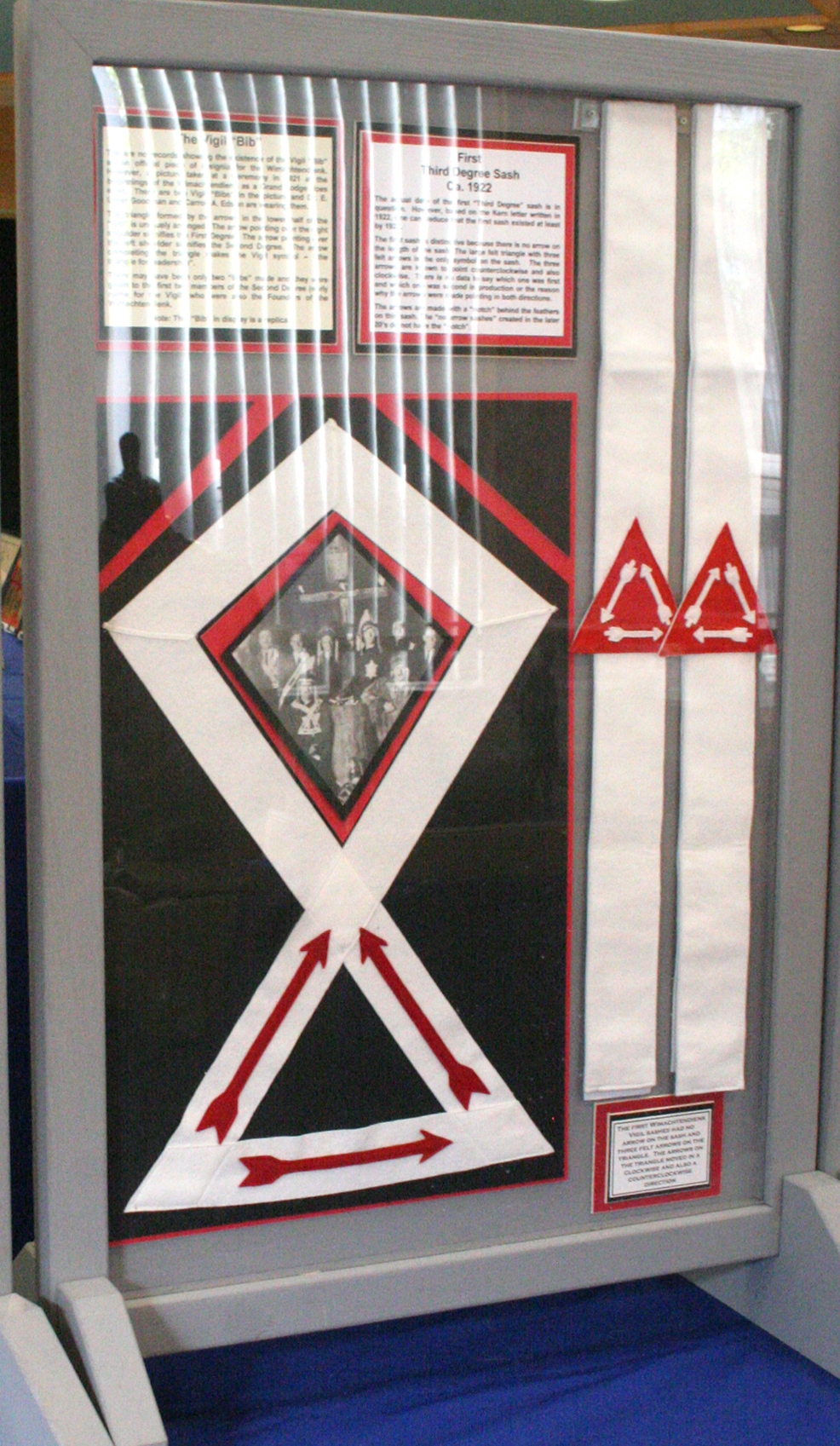 ritten by Dr. William Hinkle has a line in it that moves the band from the right shoulder to the left shoulder just before the conclusion of the ceremony. There is no description of the design, color or material. This is the earliest reference that the First Degree (Ordeal) band and the Second Degree band (Brotherhood) were the same sash, just worn over different shoulders.
ritten by Dr. William Hinkle has a line in it that moves the band from the right shoulder to the left shoulder just before the conclusion of the ceremony. There is no description of the design, color or material. This is the earliest reference that the First Degree (Ordeal) band and the Second Degree band (Brotherhood) were the same sash, just worn over different shoulders.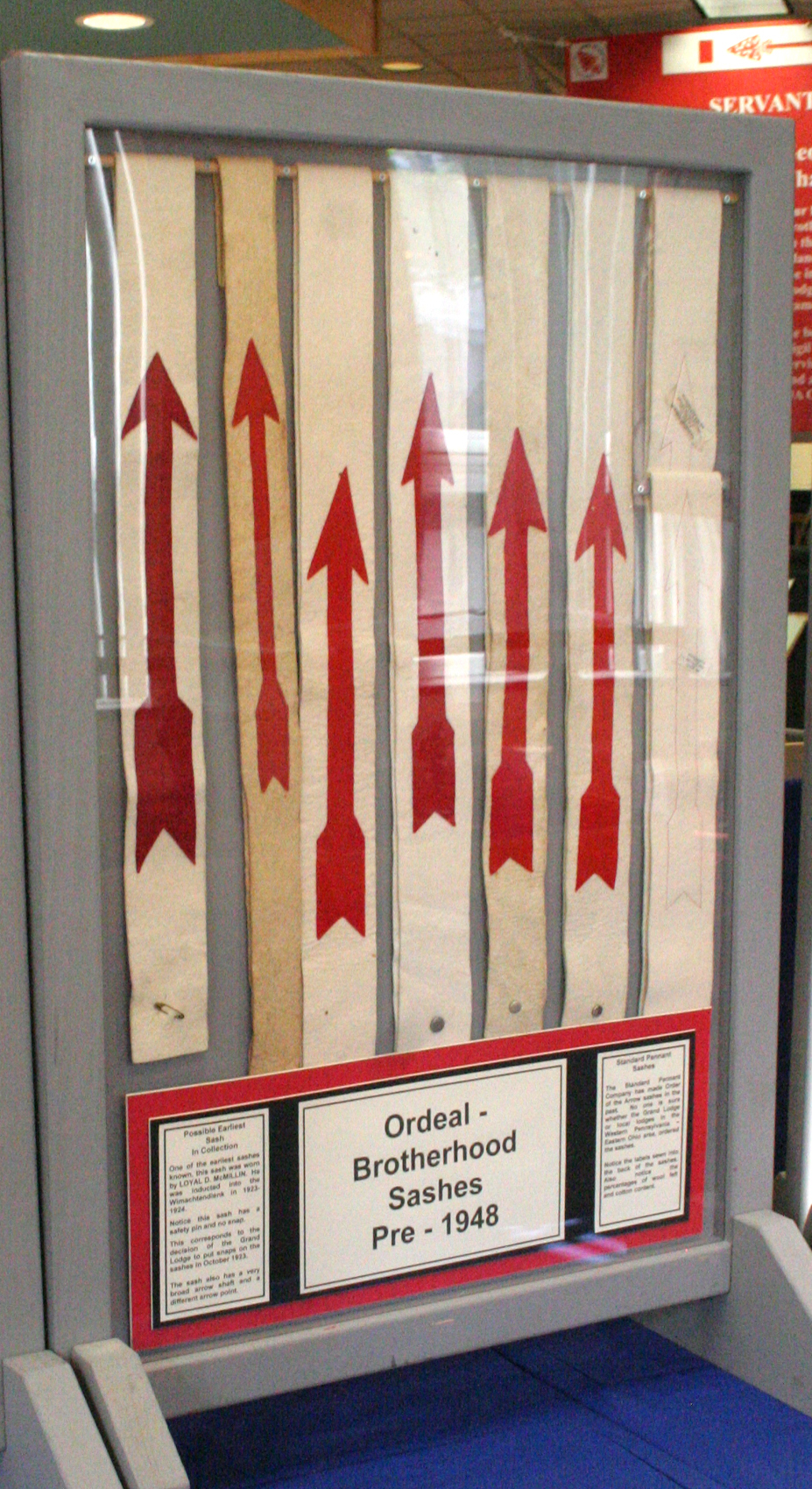 The First Degree/Second Degree (Ordeal/Brotherhood) bands created by the Grand Lodge were white wool-felt bands with red wool-felt arrows sewn on. The Vigil Honor band was the white wool-felt band with no arrow sewn onto the band. There was a large triangle sewn onto the middle of the band on the front. Sewn onto each side of the large red triangle were three small white arrows made of wool felt.
The First Degree/Second Degree (Ordeal/Brotherhood) bands created by the Grand Lodge were white wool-felt bands with red wool-felt arrows sewn on. The Vigil Honor band was the white wool-felt band with no arrow sewn onto the band. There was a large triangle sewn onto the middle of the band on the front. Sewn onto each side of the large red triangle were three small white arrows made of wool felt.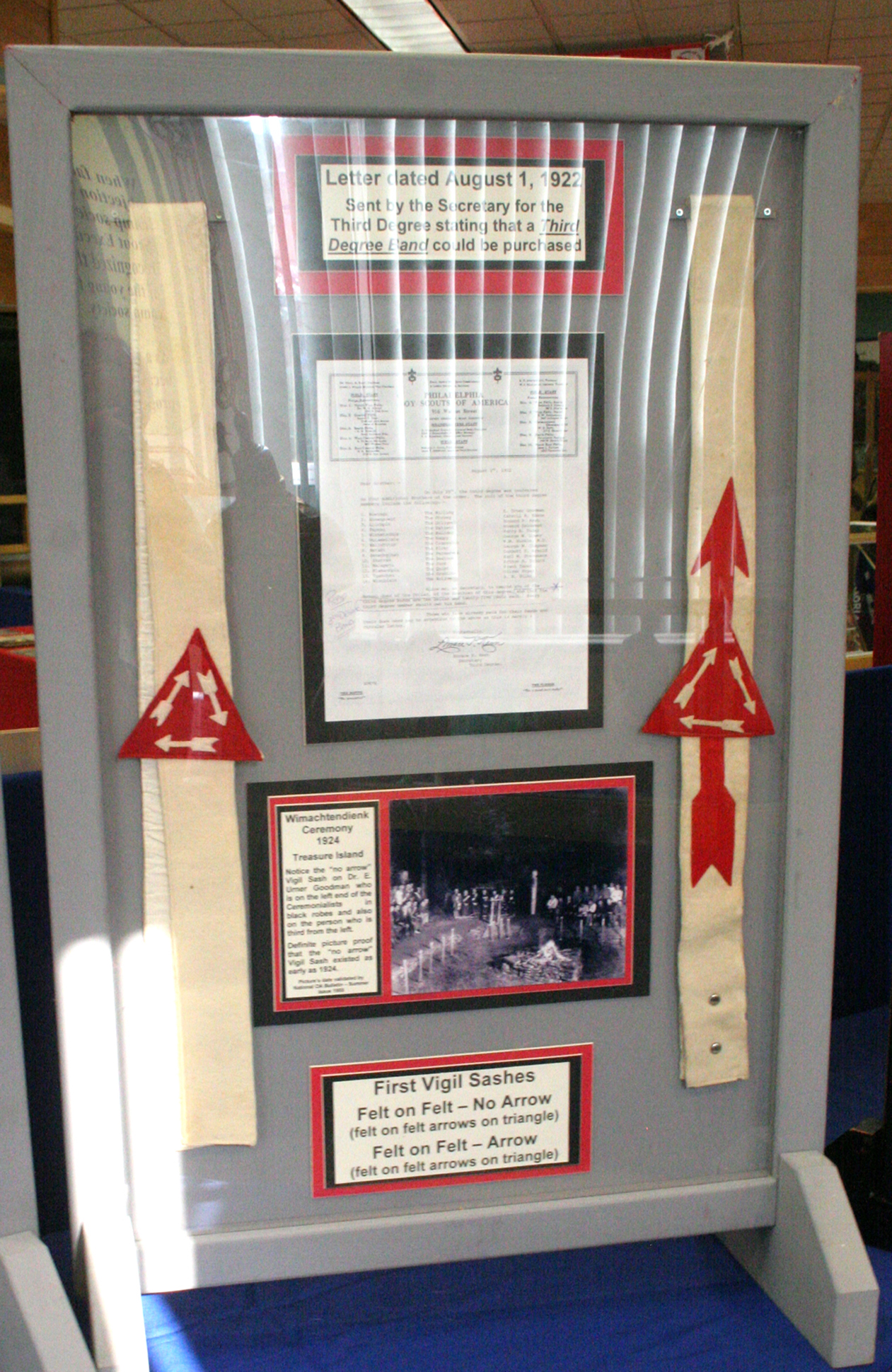 changed all sashes. The sash material remained the wool-felt. However the arrow was red-flocked silk-screening onto the wool-felt. Flocking is the process of silk-screening crushed felt with ink using an electro-static charge to make the felt stand-up creating a velvet like appearance. The Vigil Honor sash had a large red wool-felt triangle with the small arrows silkscreened onto it. The large triangle was sewn onto the Ordeal/Brotherhood band/sash. These large triangles exist with both flocked and non-flocked white arrows.
changed all sashes. The sash material remained the wool-felt. However the arrow was red-flocked silk-screening onto the wool-felt. Flocking is the process of silk-screening crushed felt with ink using an electro-static charge to make the felt stand-up creating a velvet like appearance. The Vigil Honor sash had a large red wool-felt triangle with the small arrows silkscreened onto it. The large triangle was sewn onto the Ordeal/Brotherhood band/sash. These large triangles exist with both flocked and non-flocked white arrows.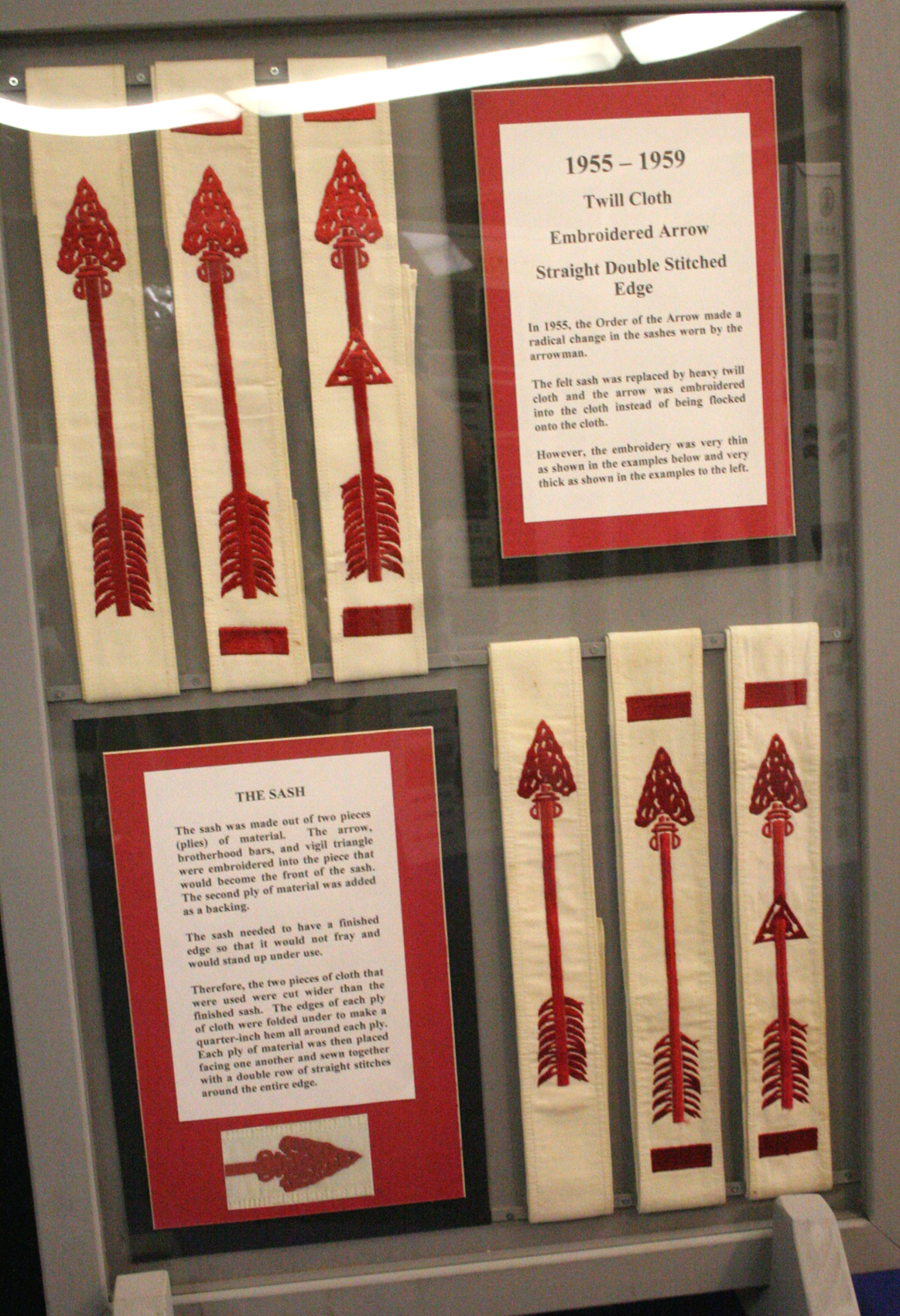 In 1955 a completely new sash was introduced. Gone were the wool-felt and silk-screening. The new sashes were twill material with embroidery. The sash was made out of two plies of material so that the embroidered red arrow did not show on the back. It also gave bulk to the sash. The plies were sewn together with a distinctive two-track stitch.
In 1955 a completely new sash was introduced. Gone were the wool-felt and silk-screening. The new sashes were twill material with embroidery. The sash was made out of two plies of material so that the embroidered red arrow did not show on the back. It also gave bulk to the sash. The plies were sewn together with a distinctive two-track stitch.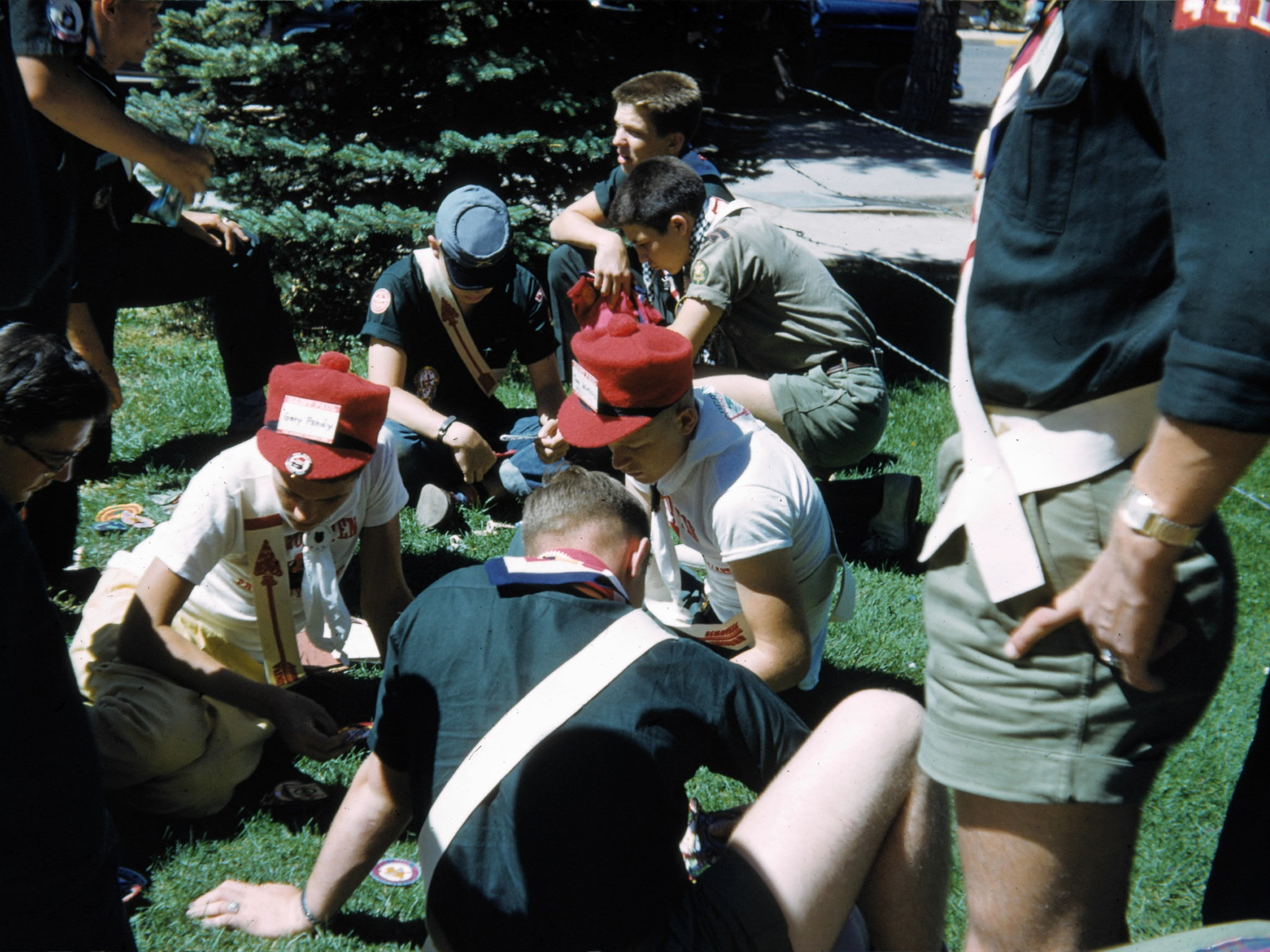 The patch-trading hobby continued to grow throughout the 1950s and 1960s. Hobby newsletters were developed such as The Trader which emerged following the
The patch-trading hobby continued to grow throughout the 1950s and 1960s. Hobby newsletters were developed such as The Trader which emerged following the 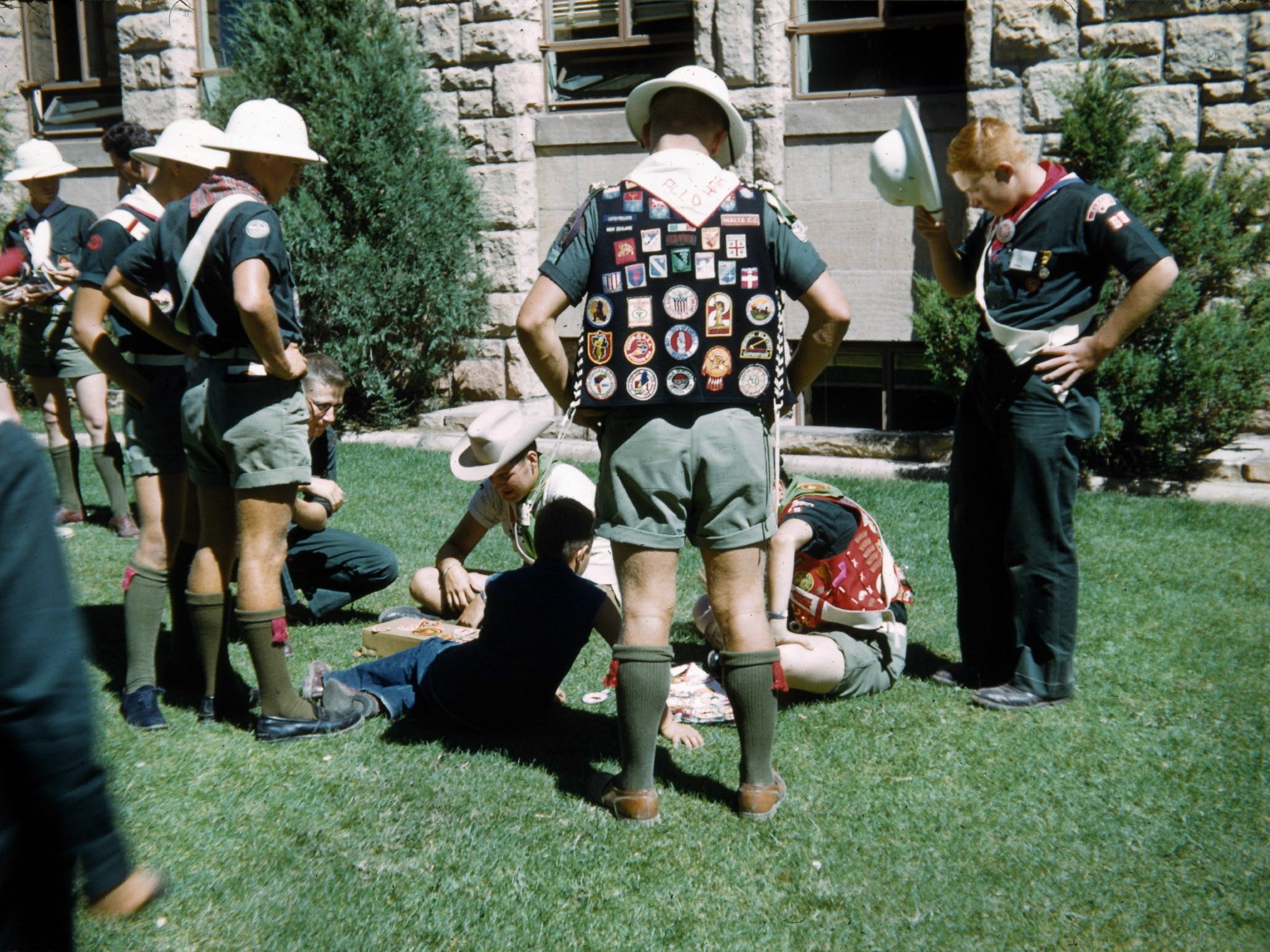 One part of the change was that patch “traders” were becoming patch “collectors”. There was a heightened awareness that program must come first and that collectors needed to police themselves. More books were being produced. National and regional books were being written and published that provide the history of insignia. Arrowmen started paying more and more attention to their locally issued items. Patch organizations such as National Scout Collectors Society, Western Traders Association, the American Scouting Historical Society and American Scouting Traders Association (ASTA) and later the International Scout Collectors Association (ISCA) formed. They included a code of ethics. Among rules were not mailing council offices and not trading during training sessions and always following the rules of the event (
One part of the change was that patch “traders” were becoming patch “collectors”. There was a heightened awareness that program must come first and that collectors needed to police themselves. More books were being produced. National and regional books were being written and published that provide the history of insignia. Arrowmen started paying more and more attention to their locally issued items. Patch organizations such as National Scout Collectors Society, Western Traders Association, the American Scouting Historical Society and American Scouting Traders Association (ASTA) and later the International Scout Collectors Association (ISCA) formed. They included a code of ethics. Among rules were not mailing council offices and not trading during training sessions and always following the rules of the event (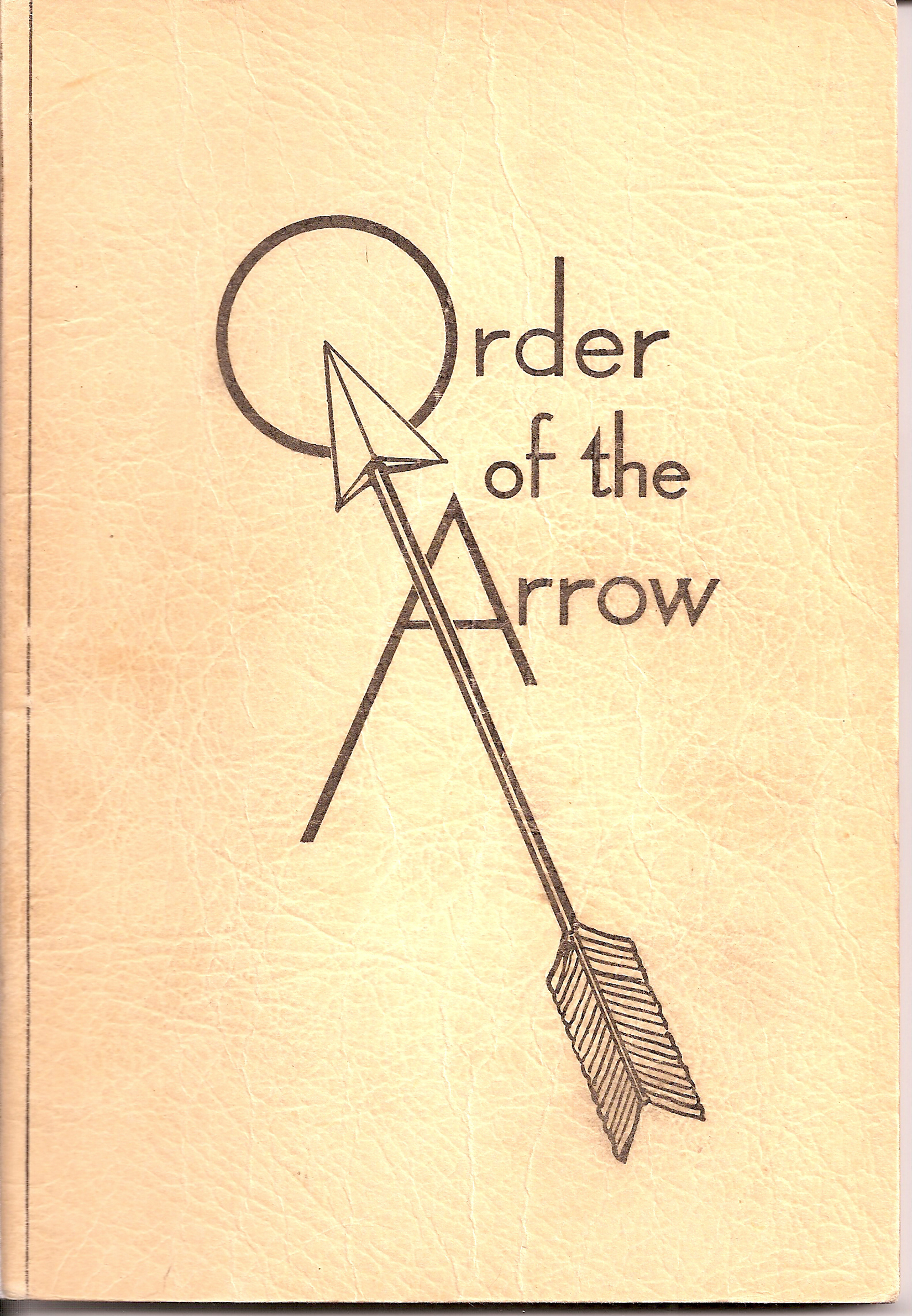
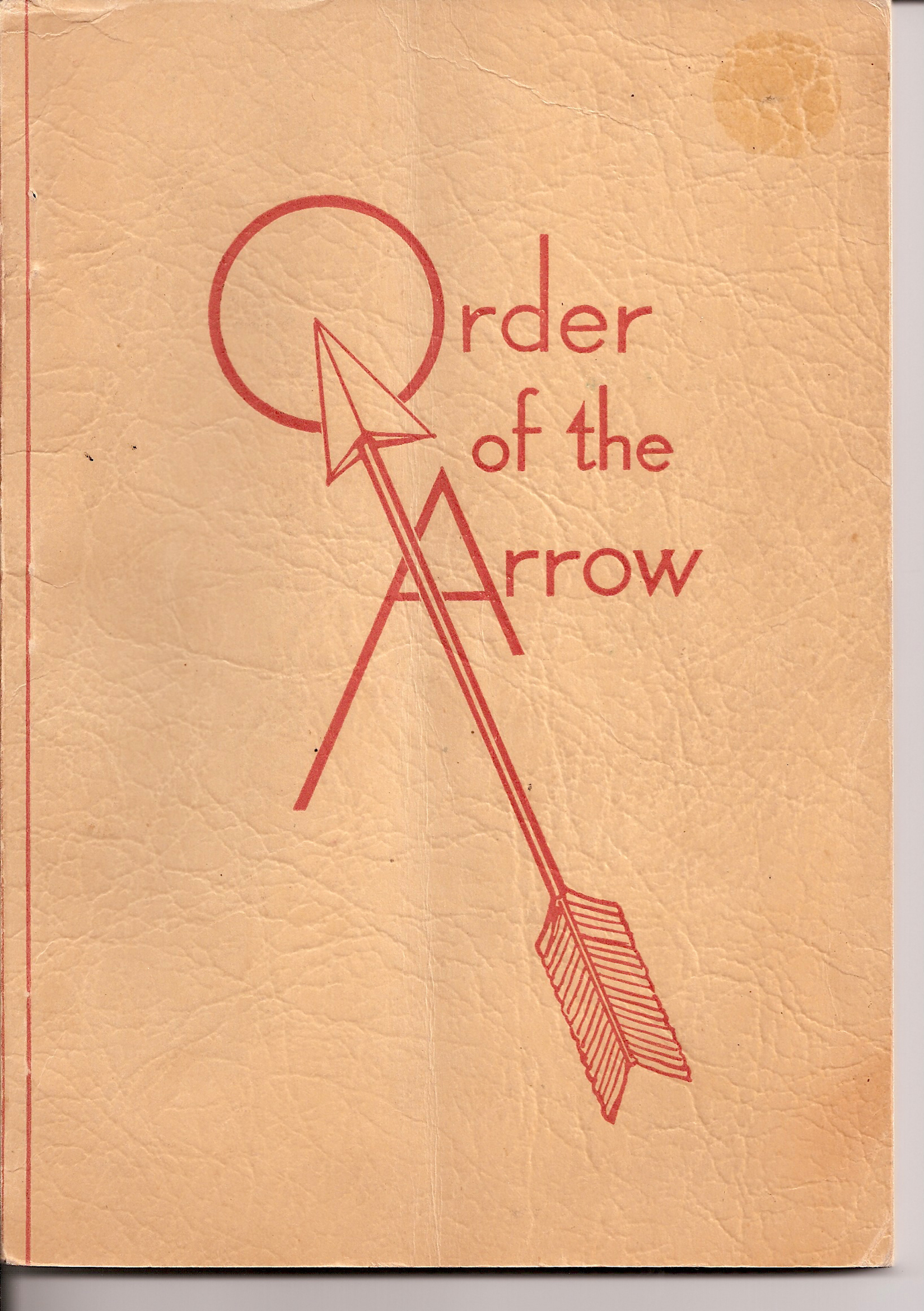
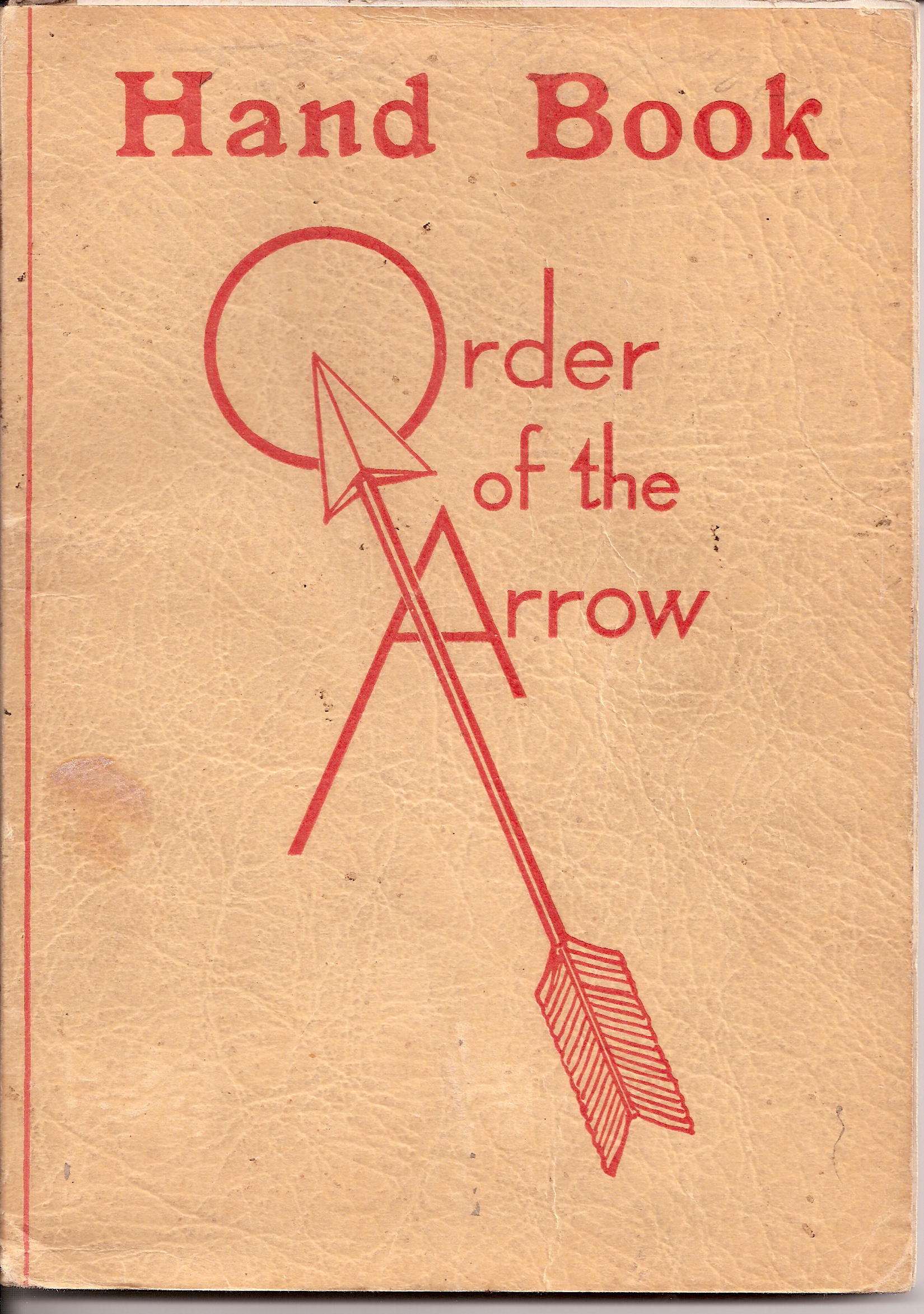
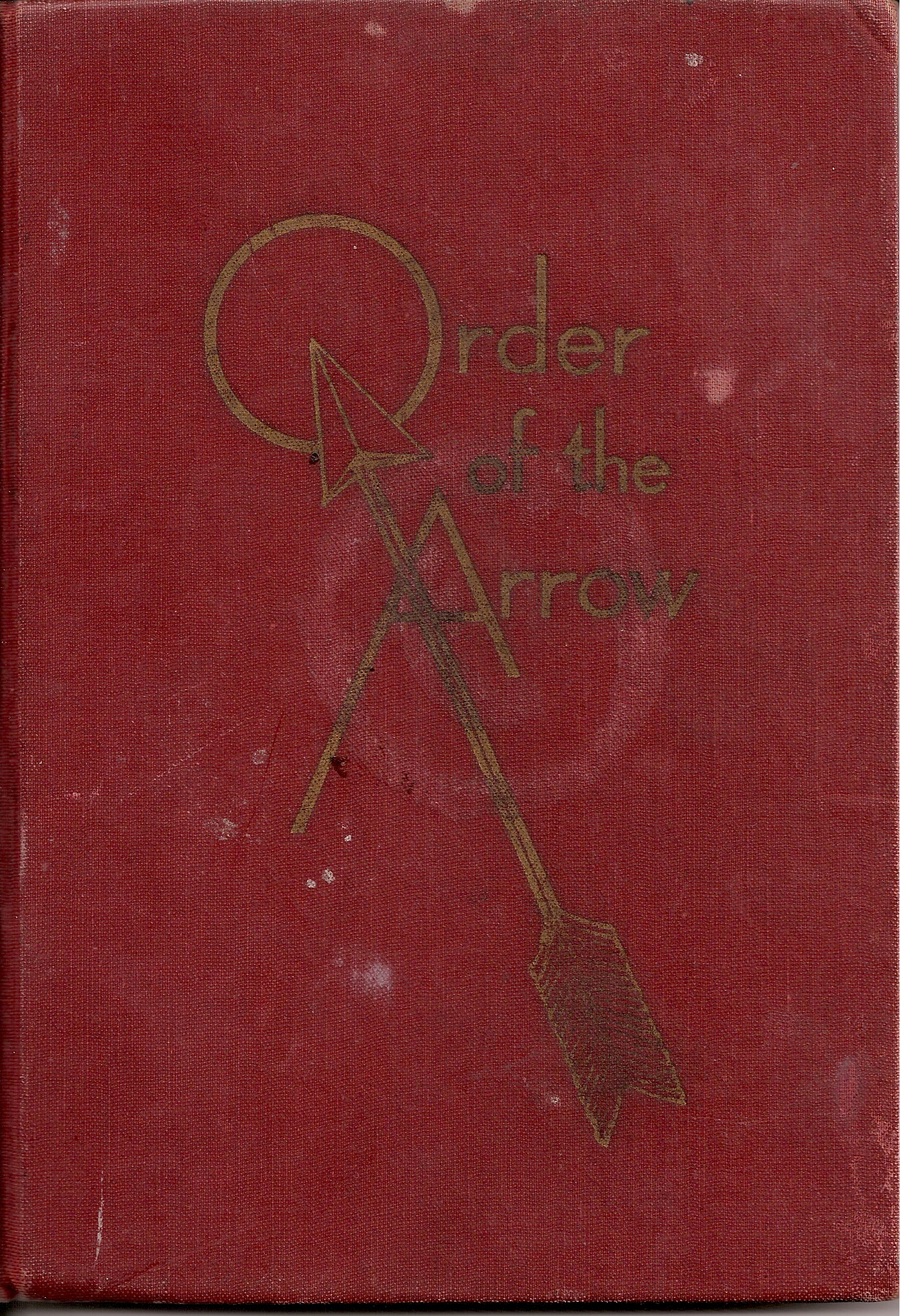
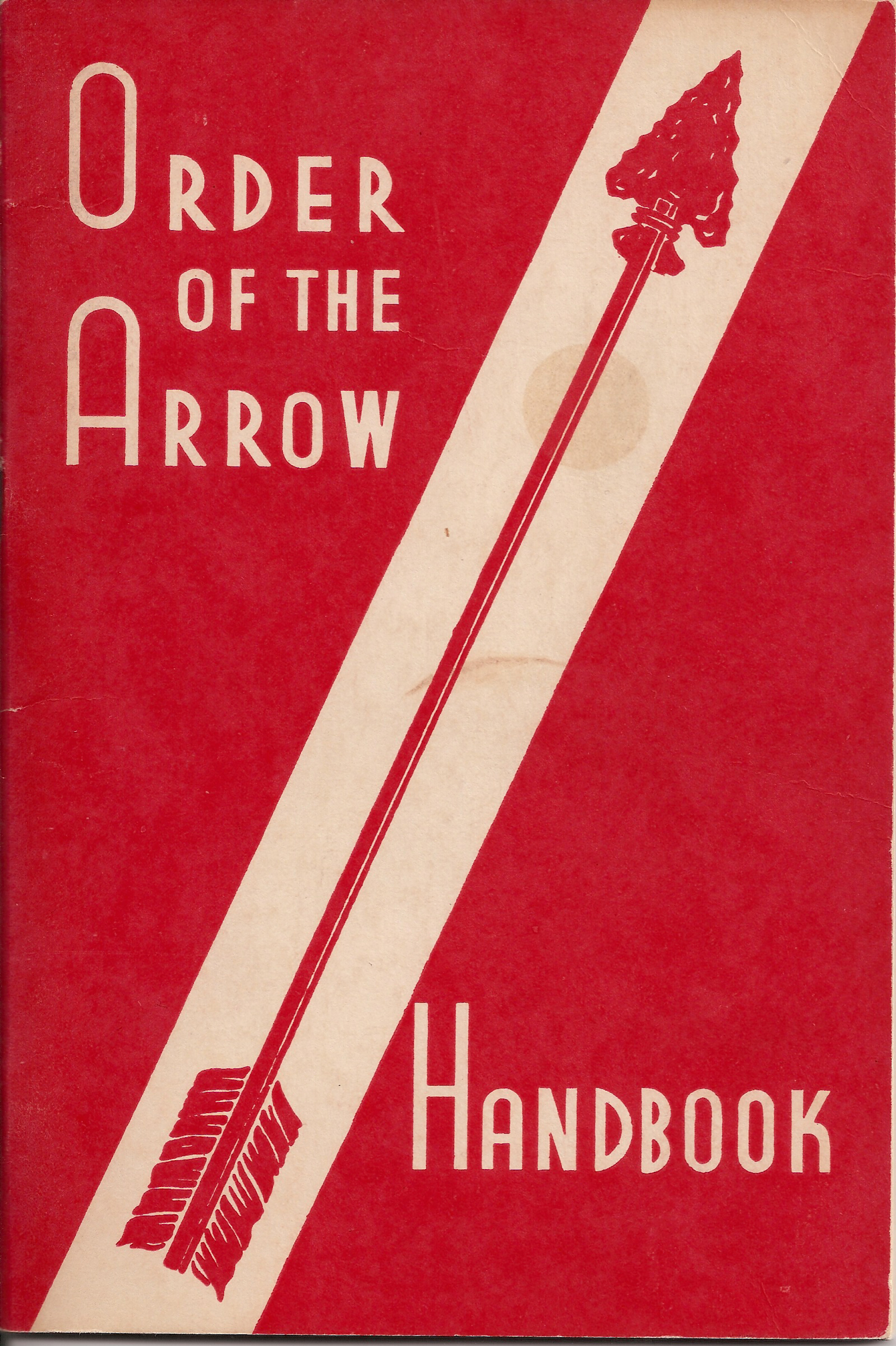 1950 brought a new handbook and its contents were similar. The following was the Table of Contents:
1950 brought a new handbook and its contents were similar. The following was the Table of Contents: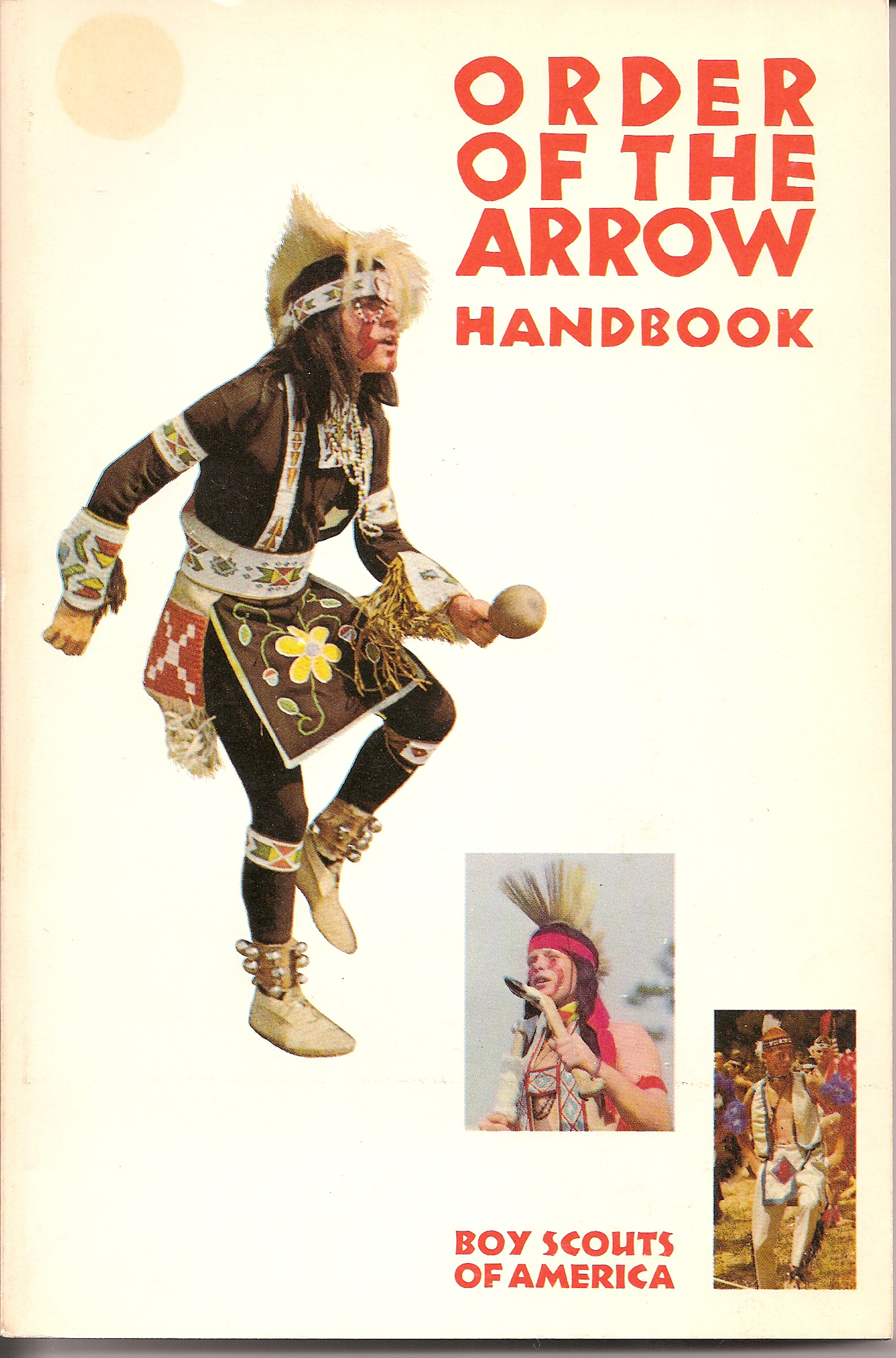 In 1973, the contents of the book were presented in a more creative way:
In 1973, the contents of the book were presented in a more creative way: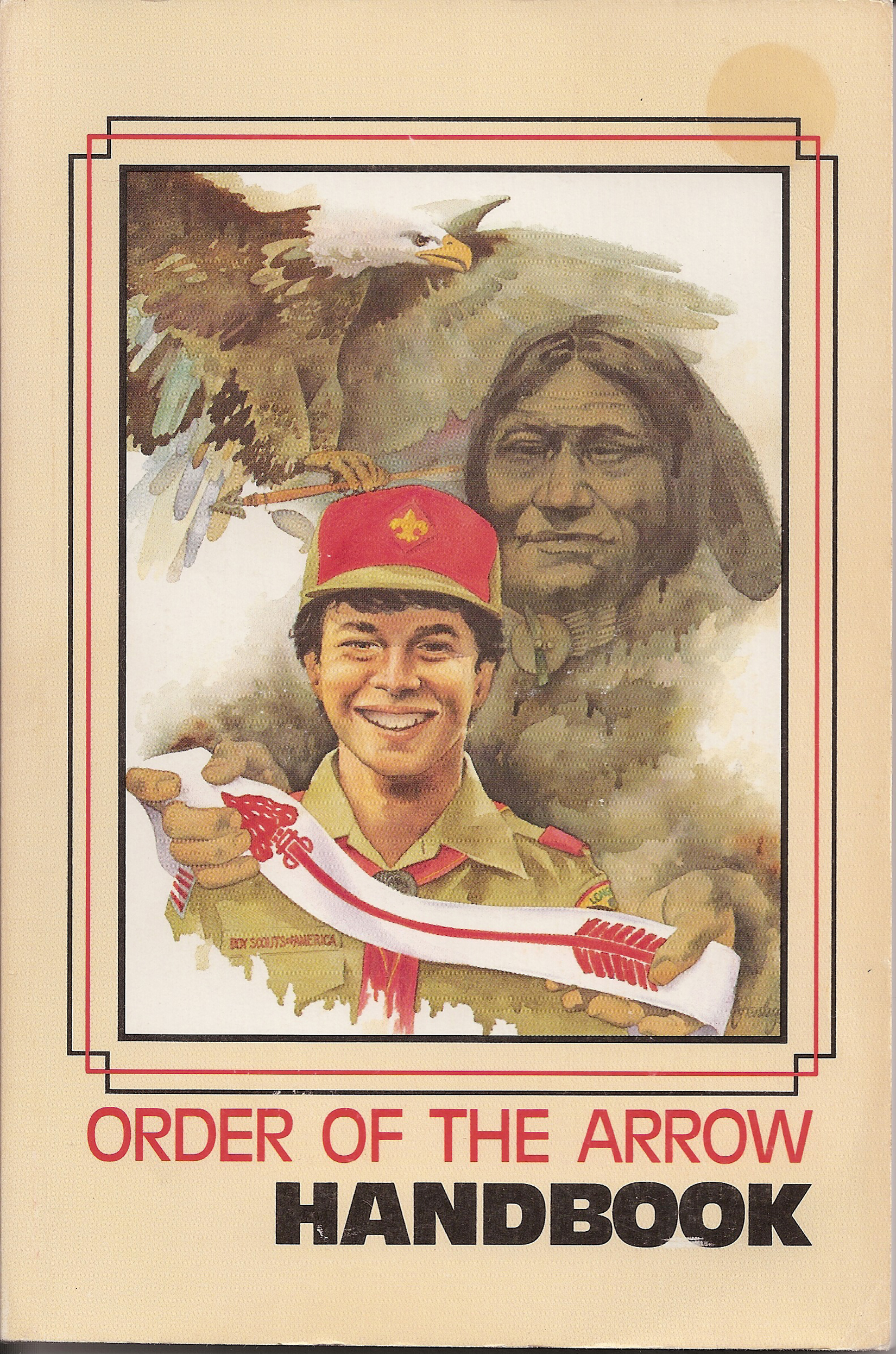 The basic content of the OA Handbook has not changed since the 1989 revision.
The basic content of the OA Handbook has not changed since the 1989 revision.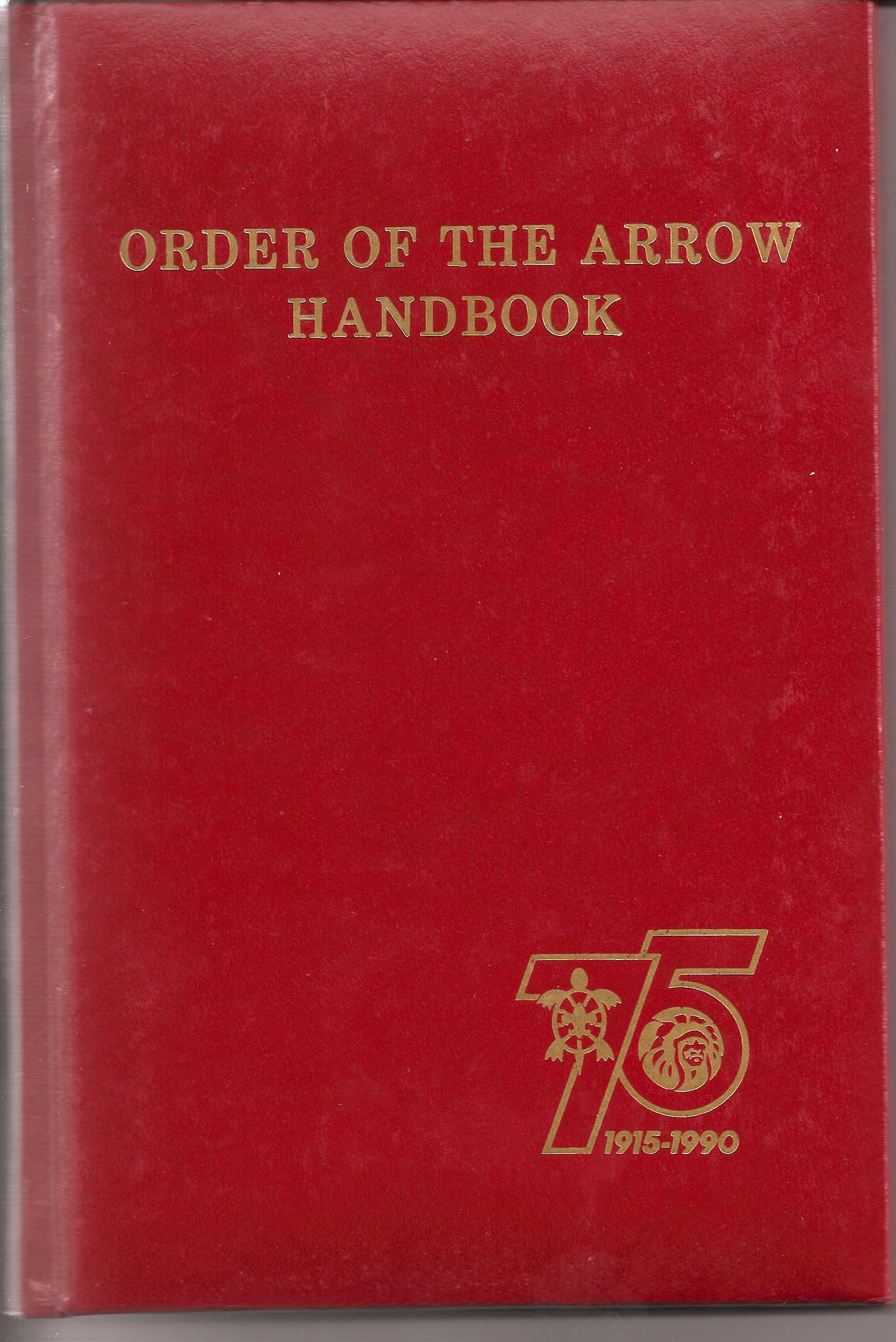 Each of these handbooks had distinctive covers and the 1990 edition was published with a leather cover and binding.
Each of these handbooks had distinctive covers and the 1990 edition was published with a leather cover and binding. The first recipients were recognized at the
The first recipients were recognized at the 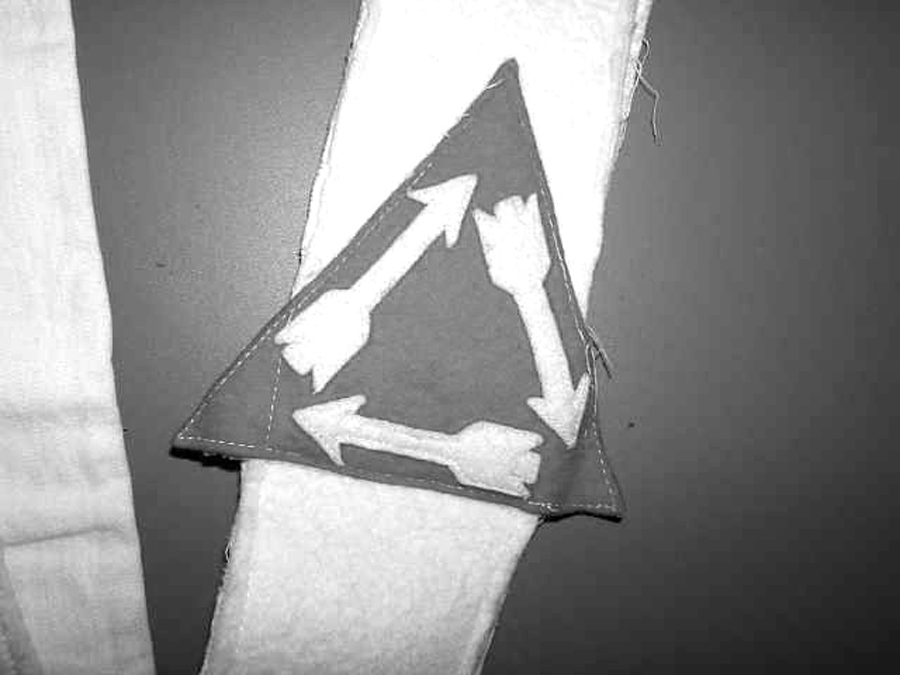 ver the left shoulder appeared in 1922. In a letter, dated August 1, 1922 on Philadelphia Council stationery,
ver the left shoulder appeared in 1922. In a letter, dated August 1, 1922 on Philadelphia Council stationery,